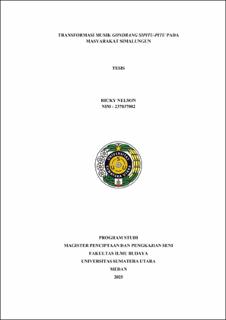| dc.description.abstract | This study examines the process of transformation and adaptation of gondrang
sipitu-pitu music in the Simalungun society in response to social, cultural, and
technological dynamics. Gondrang sipitu-pitu music, which originally functioned
as a medium of ritual and spiritual communication in the context of Simalungun
customs, underwent significant changes in musical structure, social function, and
presentation style due to the entry of religion, modernization, and foreign cultural
influences. The research uses a descriptive qualitative method with a
phenomenological approach, and is supported by Margaret Kartomi's theory of
transformation and adaptation, Jeff Todd Titon's theory of musical style, and
William F. Ogburn's theory of socio-cultural change. The findings show that
although modern instruments are starting to shift the dominance of traditional
instruments, important elements such as rhythm, saruni melodies, and ensemble
structures are still retained. The musical style that is formed reflects the creative
adaptation of traditional artists to the demands of contemporary performance
spaces. However, this transformation cannot be separated from critical problems
such as the loss of sacred meaning, the pressure of modern aesthetics, and the
tendency to commodify local culture. The change in the function of gondrang from
a spiritual rite to a popular entertainment leaves questions about the authenticity
and sustainability of cultural values. Therefore, this transformation needs to be
understood not only as an adaptive process, but also as an arena for contesting
meaning, identity, and cultural power in the Simalungun society. | en_US |


